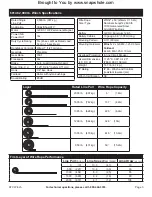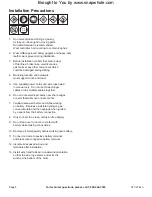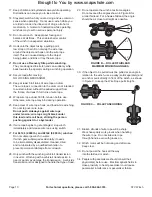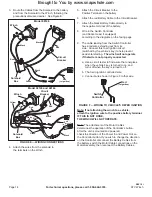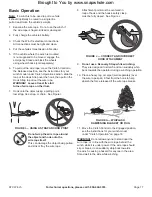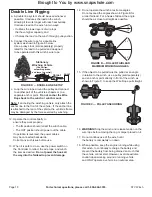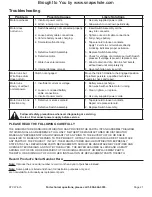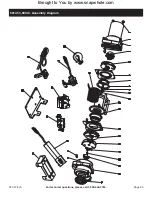
Page 10
For technical questions, please call 1-800-444-3353.
ATV Winch
17. Keep children and bystanders away while operating.
Distractions can cause you to lose control.
18. Stay alert, watch what you are doing and use common
sense when operating. Do not use a winch while you
are tired or under the influence of drugs, alcohol or
medication. A moment of inattention while operating
winches may result in serious personal injury.
19. Do not overreach. Keep proper footing and
balance at all times. This enables better control
of the winch in unexpected situations.
20. Hook onto the object using a pulling point,
tow strap or chain. Do not wrap the wire rope
around the object and hook onto the wire rope
itself. This can cause damage to the object
being pulled, and kink or fray the wire rope.
21.
Do not use a Recovery Strap while winching.
They are designed to stretch and can suddenly whip
back towards the operator during a winching operation.
22. Secure load after moving.
NO LOCKING MECHANISM.
23. Keep at least 5 full turns of wire rope on drum.
The wire rope’s connection to the drum is not intended
to sustain a load, without the added support from
the friction of at least 5 full turns of wire rope.
24. Wrap wire rope under 500 lb. tension before use.
Otherwise, wire rope may bind during operation.
25. Keep clear of wire rope, hook, and load while winching.
Do not step over wire rope.
Do not push sideways against wire rope
under tension; wire rope might break under
this load and recoil back, striking the person
pushing against it or a bystander.
26. If wire rope begins to get entangled, stop winch
immediately and release wire rope using switch.
27.
For 68146 (2,000 lb.) and 68144 (5,000 lb.) winches:
Do not submerge winch in water.
If winch gets submerged accidentally, it needs
to be immediately disassembled, cleaned, dried
and re-lubricated by a qualified technician to
prevent permanent damage from corrosion.
28. Only winch with the winching vehicle′s transmission
in neutral. Winching with a vehicle′s transmission in
gear or park may damage the transmission. A vehicle′s
transmission is not designed to handle that type of load.
29. Do not operate the winch at extreme angles.
Do not exceed the angles shown in Figure B for
a roller fairlead. For a hawse fairlead, the angle
should be as close to straight as possible.
FIGURE B — ROLLER FAIRLEAD
AXIU WINCHING ANGLES
15°
15°
45°
45°
30. If the object to be pulled must be pulled at an angle in
relation to the winch, use a pulley (sold separately) and
an anchor point directly in front of the winch, as shown
in Figure C, to keep the Wire Rope pull straight.
FIGURE C — PULLEY ANCHORING
31. Broken strands of wire rope will be sharp.
Wear heavy-duty work gloves when handling
the wire rope. Do not slide wire rope
through hands, even with gloves on.
32. Winch motor will be hot during and after use.
Keep clear.
33. Do not power the hook all the way
into the fairlead or winch.
34. People with pacemakers should consult their
physician(s) before use. Electromagnetic fields in
close proximity to heart pacemaker could cause
pacemaker interference or pacemaker failure.
Brought to You by www.snapwhole.com



